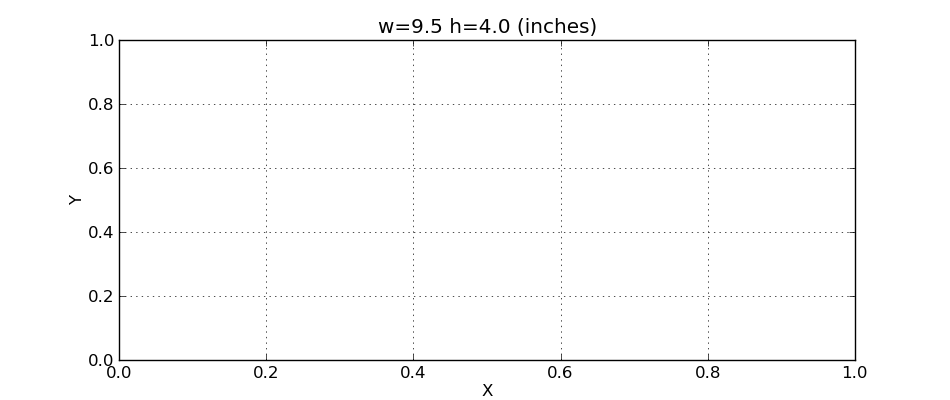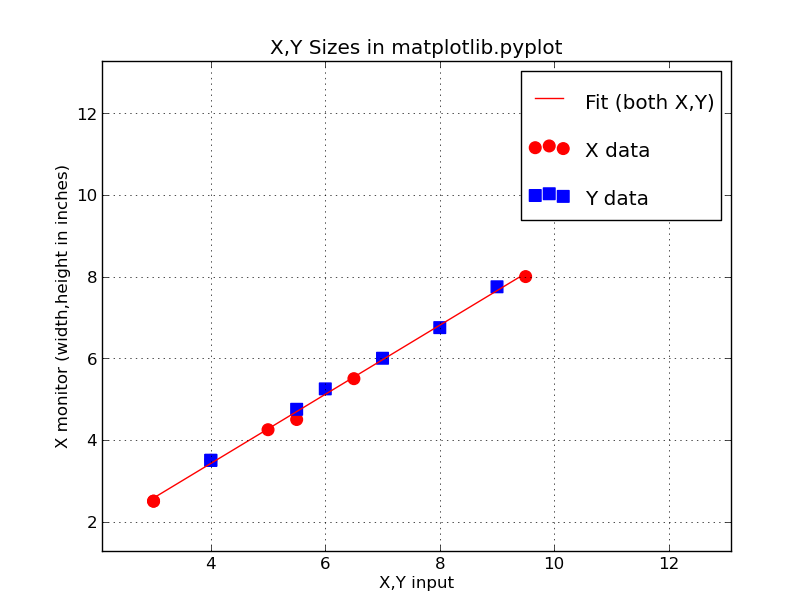Making plots an exact size.
I used the code ts_plot.py to assure that I got the same scale
on the X,Y axues of a plot. But waht if I want the data plotted
to a specific scale?
- An experimental code.
- Compiling and measuring plots.
An experimental code.
Here is a simple code that I use to make FIGURES of a different sizes.
#!/usr/bin/env python
import argparse as ARGP
parser = ARGP.ArgumentParser()
parser.add_argument("arg1", help="figure width in inches")
parser.add_argument("arg2", help="figure height in inches")
parser.add_argument("-v","--verbose", help="Verbose responses",
action="store_true")
args = parser.parse_args()
# Setup to read the name of the input file
width_inch = args.arg1
height_inch = args.arg2
# Numpy is a library for handling arrays (like data points)
import numpy as npsubs
# Pyplot is a module within the matplotlib library for plotting
import matplotlib.pyplot as plt
label_main = "w=%s h=%s (inches)" % (width_inch,height_inch)
label_xaxis = "X"
label_yaxis = "Y"
xlo="0.0"
xhi="1.0"
ylo="0.0"
yhi="1.0"
verbo = args.verbose
#print verbo
if args.verbose:
print "Plot (for sco) title = %s\n" % (label_main),
print "X-axis title = %s\n" % (label_xaxis),
print "Y-axis title = %s\n" % (label_yaxis),
print "X range = %s %s \n" % (xlo, xhi),
print "Y range = %s %s \n" % (ylo, yhi),
#=========================================================
#plt.axes(aspect=1)
wid = float( width_inch )
hei = float( height_inch )
plt.figure(figsize=(wid,hei))
#=========================================================
# add some fancy touches
plt.grid(True)
#plt.legend()
xlim1 = float(xlo)
xlim2 = float(xhi)
ylim1 = float(ylo)
ylim2 = float(yhi)
plt.xlim(xlim1,xlim2)
plt.ylim(ylim1,ylim2)
# label the axes
plt.title(label_main)
plt.xlabel(label_xaxis)
plt.ylabel(label_yaxis)
plt.savefig('pxy.png')
#print '\nUse to view your plot:\ndisplay pxy.png\n'
To run this code:
% prun 9.5 4.0 001
% prun p001.png
 |
I wanted to understand how to specify the size and scale
of a matplotlib.pyplot figure.
To make this plot:
% prun 9.5 4.0 001
% display p001.png
The final plot has a figure size that has a width of 10.25 inches
and height of 4.5 inches. The actual size of the X,Y axes (in the
display monitor) is a width of 8.0 inches and a height of 3.5 inches.
|
Compiling and measuring plots.
Using the code in the previous section I made a script to
run lots of plot examples using different sizes:
% cat BIGRUN
#
prun 3.0 8.0 001
prun 4.0 7.0 002
prun 5.0 6.0 003
prun 3.0 5.5 004
prun 5.5 4.0 005
prun 6.5 9.0 006
prun 9.5 4.0 007
Next I measured the plots and compiled a file of the measurements.
% cat Table.dat
# col01: name
$ col02: X input
$ col02: Y input
# data
p001.png 3.00 8.00 2.50 6.75
p002.png 4.00 7.00 3.50 6.00
p003.png 5.00 6.00 4.25 5.25
p004.png 3.00 5.50 2.50 4.75
p005.png 5.50 4.00 4.50 3.50
p006.png 6.50 9.00 5.50 7.75
p007.png 9.50 4.00 8.00 3.50
To make the plots
% xyplotter_prep Table.dat 1
Enter plot title:X data
Enter X,Y column numbers (1 2): 2 4
Enter X,Y error column numbers (0 0): 0 0
Enter X-axis label:X input
Enter Y-axis label:X monitor width
You are set up to make a plot with Table.dat
Here is the command line to use:
xyplotter List.1 Axes.1
% xyplotter List.1 Axes.1
Then I could modify the files List.1 and Axes.1 to get:
% cat List.1
Table.dat 2 4 0 0 point r o 70 X data
Table.dat 3 5 0 0 point b s 70 Y data
% cat Axes.1
X,Y Sizes in matplotlib.pyplot
1.0 12.0 X input
0.0 12.0 X monitor width
I fit both sets of data with a line:
Size_Monitor = 0.038 + 0.846 * Size_Input
-+0.07 -+0.012
Here is the plot I get.
 |
The X,Y sizes of sizes I measure on my monitor verses the
X,Y sizes I input the matplotlib.
I fit both sets of data with a line:
Size_Monitor = 0.038 + 0.846 * Size_Input
-+0.07 -+0.012
Practical (working) equation:
Size_Input = 1.182 * Size_Monitor - 0.045
Hence, if I wanted to make a square that is 6" x 6" I would use:
% prun 7.047 7.047 200
% display p200.png
At some point I'll measure these plots on paper and derive the same sort
of linear fit. For now, I'll use the above relation to set the X,Y sizes on
on my plots. Actually, what I want to specify is size on the monitor (or paper
print) and then predict the figure size (Size_Input). So the working equation
is really the second equation above.
|
Back to calling page

